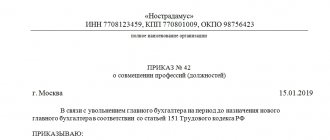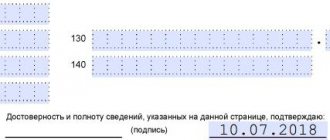In modern economic conditions, many workers are not limited to one position and workplace. In their free time from their main job, they can perform other job duties on a regular basis, in other words, work part-time. A distinction is made between external, when the place of work is additionally a third-party company, and internal, when the employee takes another position while remaining an employee of one company. Our material will examine internal part-time work: the features of its reflection in legislation and design.
It is necessary to distinguish between internal part-time work and combination of positions. These differences will also be discussed below.
How to properly apply for a job under an employment contract for an internal part-time worker ?
Internal part-time and internal combination of positions: the difference in the formalization of relationships
An employee of the company, who is already on staff and performs a certain amount of work, decides to take on an additional load that goes beyond the scope of his current job functionality.
How can he do this? Essentially, in this case, independent labor relations between the company and the specialist come into force, which can be formalized in 2 forms:
- internal part-time job;
- combination of positions (professions).
There is a fundamental difference between the two forms that the company must understand. Namely: internal part-time work means performing work unrelated to the main one, at a time that is not occupied by the specialist’s main activity (Article 60.1, 282 of the Labor Code of the Russian Federation). In other words, the second job (internal part-time) is performed completely outside the scope of the employee’s main position.
If you have access to ConsultantPlus, find out the intricacies of registering a combination of positions, which will allow you to avoid disputes with inspectors. If you don't have access, get a free trial of online legal access.
Example:
G.V. Ivanov works as a mechanic at a manufacturing enterprise. The working day of a mechanic in production is from 9:00 to 18:00. At the same time, he decides to get a part-time job as a cleaner at the same company. He performs the labor functions of a cleaner after his working day as a mechanic ends, i.e. from 18:00 to 21:00. In this case, he does not combine positions, but performs the functions of a cleaner as his additional work on an internal part-time basis in that the same company.
Internal combination of positions assumes that a specialist continues to work within the framework of his main job duties and, in addition, during the generally established working day manages to perform other functions corresponding to another position. That is, a specialist is engaged in work to combine another position in parallel with his main work, at the same time (Article 60.2, 151 of the Labor Code of the Russian Federation).
Example:
G.V. Ivanov from the previous example works as a mechanic, but in addition, during the working day (from 9:00 to 18:00) he also has time to clean the workshop. Such relationships can be formalized as a combination of the professions of a mechanic and a cleaner within one production enterprise.
The above features also determine differences in the design of labor relations. Namely: for an internal part-time worker it is necessary to draw up a separate employment contract. When combining positions, the previous employment contract is sufficient, but an additional agreement must be issued to it.
Are there any restrictions?
Laws separately define the circle of persons for whom the use of such schemes is prohibited. Additional employment cannot be entered for:
- Civil servants, government. The rule applies to representatives of law firms, judicial authorities, prosecutors, and police.
- Employees whose duties are related to the constant management of transport.
- Persons working under harmful or dangerous working conditions. They are prohibited from combining positions if the new place has the same conditions.
- Managers. They can only choose external part-time work if management has agreed on this issue.
- Citizens under 18 years of age.
At the same time, scientific and research activities are not prohibited for such citizens.
Work on combining positions: registration
If an employee wants and can work in 2 positions in the company at the same time, then the preferable option for him is to formalize additional relations with the employer in the form of combining positions. But for this it is important that the specifics of the work allow it to be performed without release from the main activity and at the main workplace. Therefore, if the second position requires, for example, moving from the main place of work (to another workshop), then such an additional load on the employee should be formalized as an internal part-time job, and not as work combining positions.
The company can formalize the combination of positions by an additional agreement to the employee’s current employment contract, which, in particular, will specify what position he intends to combine, as well as the period during which the combination of positions will take place (Article 72 of the Labor Code of the Russian Federation).
In addition, for work combining positions, the employee must, by virtue of Art. 60.2 of the Labor Code of the Russian Federation, receive an additional payment, the amount (or calculation method) of which should also be fixed in an additional agreement to the employment contract.
The grounds for drawing up such an agreement when combining positions are the following documents (depending on who initiated the combination):
- the company’s proposal to combine positions signed by the employee;
- application from an employee requesting permission to combine positions.
At the same time, it is important for the company to remember that in the work book of a specialist who combines several positions, there is no need to reflect the fact of combination, since such an obligation is not provided for by law.
In addition, companies often have a question: should the time spent by a specialist on a combined position be recorded in a time sheet? In accordance with the norms of labor legislation, combination work is not separately highlighted in the timesheet. After all, an employee performs combined work in parallel, at the same time in which he is busy with his main job. Therefore, only the hours spent on the main work need to be recorded in the time sheet.
Order on internal combination - sample
After signing the additional agreement, the company should issue a corresponding order.
Russian labor legislation does not contain a specific unified form for such an order.
At the same time, it should indicate which positions the employee will combine, for what period and for what additional payment. In this case, as a basis for combination, the order must specify the details of the additional agreement drawn up with the employee.
A sample order can be viewed on our website:
Completion of combining positions
As mentioned above, if a company organizes a combination of positions, then the period during which such combination will be valid is determined in advance. Therefore, the question arises: what will happen after this period?
The combination ceases to be valid, i.e. the employee is further obliged to perform only his main duties. At the same time, the legislator does not provide for the need to draw up any special document closing the combination.
Therefore, everything here remains at the discretion of the company: you can issue a special order that terminates the employee’s combined powers, or you don’t have to do this - the combination will still be considered completed (unless the company has issued another order extending the employee’s combined powers).
In addition, the Labor Code of the Russian Federation establishes that at any time, both one and the other party can stop combining unilaterally (Article 60.2 of the Labor Code of the Russian Federation). To do this, you simply need to send the appropriate notice (if the initiator of the cancellation is a company) or a statement (if the initiator is an employee) to the other party no later than 3 business days in advance.
ATTENTION! If the initiator of the termination of the combination is the company, then it makes sense for it to acquaint the employee with the relevant notice against a receipt, so that later it does not turn out that he, since he knew nothing about the cancellation, continued to work for some time, combining 2 positions, for which he demands appropriate remuneration.
Internal part-time work according to the Labor Code of the Russian Federation
An internal part-time worker, unlike a specialist who combines positions, by virtue of the Labor Code of the Russian Federation, works in the main company in a second, additional job, but at a time that is not occupied by the main activity (Article 282, 60.1 of the Labor Code of the Russian Federation).
The Labor Code of the Russian Federation establishes a number of restrictions regarding how much working time an employee can spend on part-time work. So, if a specialist within the same organization works in two different positions at different times, then the Labor Code of the Russian Federation allows the maximum additional workload to be performed no more than 4 hours a day.
IMPORTANT! If there is a day when an employee is released from his main job for some reason, he can do part-time work throughout the working day.
For a month in the aggregate, a part-time employee has the right to work no more than half of the monthly standard of time established for the category of workers to which he belongs (Article 284 of the Labor Code of the Russian Federation). However, sometimes an employee has the right not to be guided by the specified limit.
For more information about how much time an employee has the right to spend on part-time work, see the article “Part-time work - how many hours per week?” .
An equally important question for both internal part-time workers and their employers is: how to pay for such work? Art. 285 of the Labor Code of the Russian Federation says that payment must be established in one of 3 ways:
- in proportion to the time spent working;
- according to a piecework scheme;
- on other conditions provided for in the employment contract.
For information on the specifics of additional payment up to the minimum wage for internal part-time workers, see the article . ”
In addition to the above, companies should keep in mind that if they have someone on their staff who works part-time in addition to their main job, then they are also entitled to leave of at least 28 days (Articles 114, 115 of the Labor Code of the Russian Federation). It is combined with vacation in the main position in time, however, vacation pay is accrued separately for the main position and separately for the combined work, since the employee has 2 independent employment contracts with the company (Articles 286, 287 of the Labor Code of the Russian Federation).
An important issue that concerns, in particular, part-time women, concerns the provision of maternity benefits to them.
Read more about this in the article “Maternity benefits for part-time workers .
Is it possible to attract foreigners?
An employer who wishes to employ citizens with foreign citizenship in his company must take care of obtaining permission for such actions. The same applies to the applicant for a position in the organization.
The permit specifies only one profession. And combined work implies simultaneous employment in two directions. Therefore, a foreigner applying for an additional vacancy must take care of obtaining another work permit in a different specialization.
The manager is obliged to notify the Migration Service of each such action.
Example. In order to legally provide a position as a mechanic to a citizen of another country, a permit for this work must be issued in the name of the potential employee. The employer must also be issued permission to hire foreigners in this specialty.
How to apply for an internal part-time job
As stated above, when working on a part-time basis, a separate employment contract is drawn up. At the same time, he is subject to all the requirements that apply to similar contracts with regular full-time employees (not part-time employees).
ATTENTION! An internal part-time worker must have exactly two : for the main job and for a part-time job.
In particular, the employment contract must contain information about:
- companies;
- a position that a specialist undertakes to perform in addition to his main job;
- wage system;
- work and rest regime, etc. (Article 57 of the Labor Code of the Russian Federation).
As a general rule, such an agreement must be drawn up in writing, in 2 copies (one for the company and one for the employee).
ATTENTION! The employment contract must include information that the employee holds the position on an internal part-time basis.
Can such an employee receive more than the basic salary?
In practice, sometimes situations occur when the salary of a part-time worker turns out to be higher than the remuneration received by the main employees. This is possible in the following cases:
- if in a few hours the part-time worker manages to fulfill the norm provided for a full working day,
- when a person working part-time overworks the main employee,
- a part-time worker has higher qualifications.
In all these cases, the employer is interested in encouraging such an employee. That is why such a part-time worker will receive more than the main employees.
However, all these nuances must be included in the text of the employment contract.
Order and application for internal part-time work
According to the norms of the Labor Code of the Russian Federation, in order for an employment contract with an internal part-time worker to be considered concluded, such a specialist, among other documents, must submit to the company an application for employment on an internal part-time basis, in which, in particular, it should be indicated what additional work he intends to take on the employee, as well as at what hours he will perform it.
The prepared application must be submitted in writing to the company's human resources department.
As a general rule, after an employment contract is concluded, the company must issue an order confirming the hiring of a specialist (Article 68 of the Labor Code of the Russian Federation). The same is true for internal part-time workers. This means that there will be two : for the main position and part-time.
At the same time, there is a unified form of such an order (No. T-1), which you can download for free on our website.
In such an order, it is important to reflect the very fact of internal part-time work, and in addition, indicate the basic conditions of the specialist’s work, its nature and the mechanism of remuneration.
Results
Registration of imposing additional workload on a company employee can be expressed in 2 forms: internal part-time work and combination of positions. If an employee intends to perform labor functions in a position that requires distraction from his main job, then such labor relations must be formalized in the form of a separate employment contract on internal part-time work. At the same time, it is important for the company not to forget to receive a corresponding application from the employee, as well as issue an order to hire an internal part-time worker. If the additional position does not involve distraction from the main job, then the specialist can combine them, that is, work at the same time in several positions in the company. Registration of internal combination of positions is carried out by signing an additional agreement to an existing employment contract. The company should also receive a corresponding signed application from the employee and formulate an order to organize the combination of positions.
Sources: Labor Code of the Russian Federation
You can find more complete information on the topic in ConsultantPlus. Free trial access to the system for 2 days.
Providing leave
Annual paid leave is not provided for a part-time position.
But at the same time, the employee is released from additional duties for the period of legal rest, issued in accordance with the vacation schedule established at the enterprise or organization.
When calculating vacation funds, the additional payment accrued for additional work is taken into account (according to Article 139 of the Labor Code).
Hiring a former civil servant and all the features of this event. Do you need to complete payroll transactions? Don't worry. All the details are in our article! Tariff payment - does it have another solution? You can read everything you need to know about him at this link.









